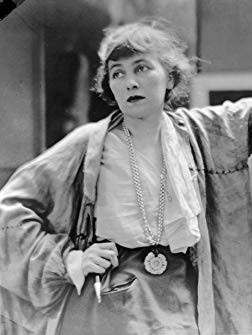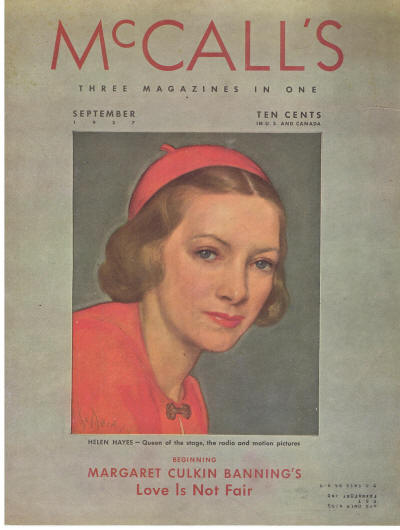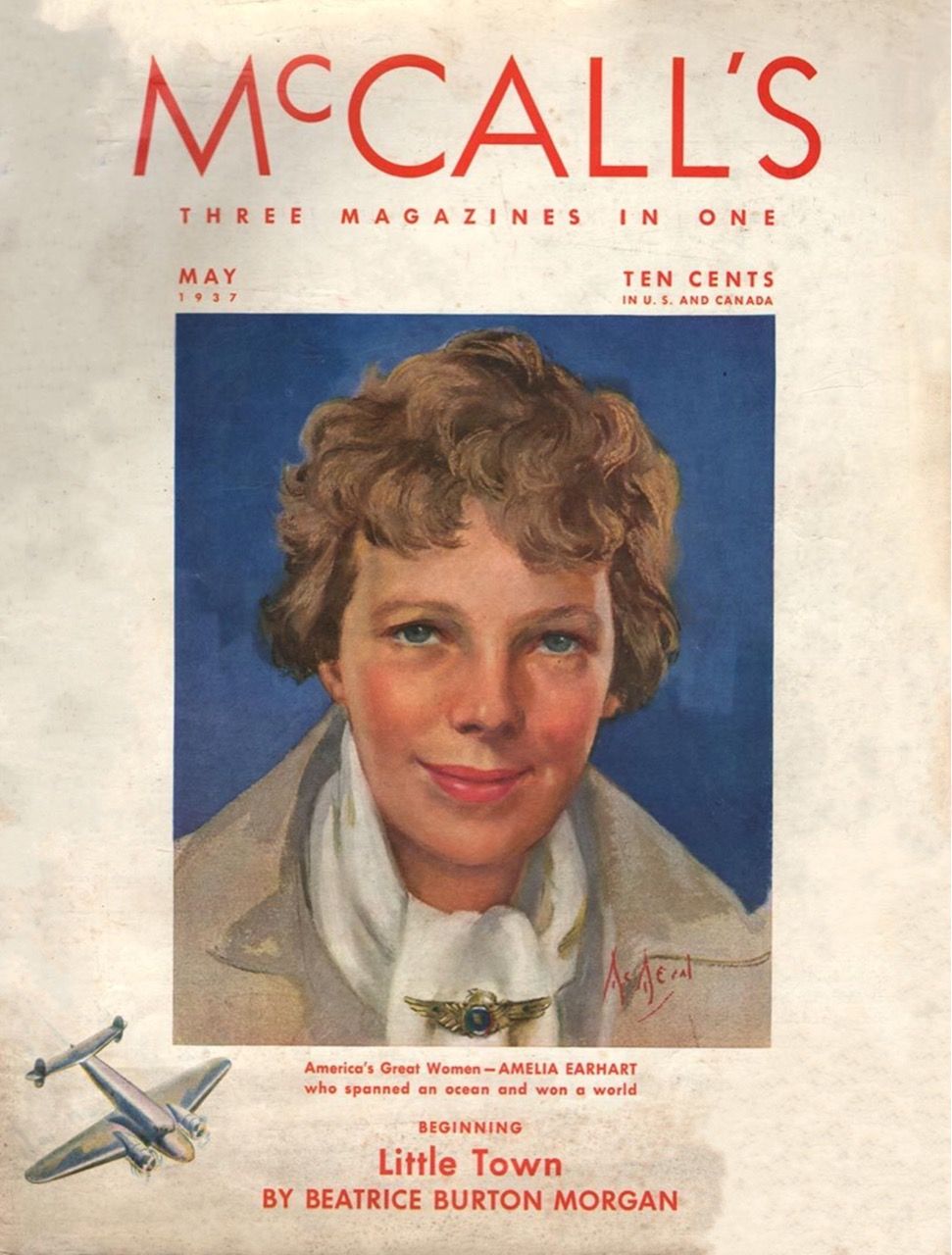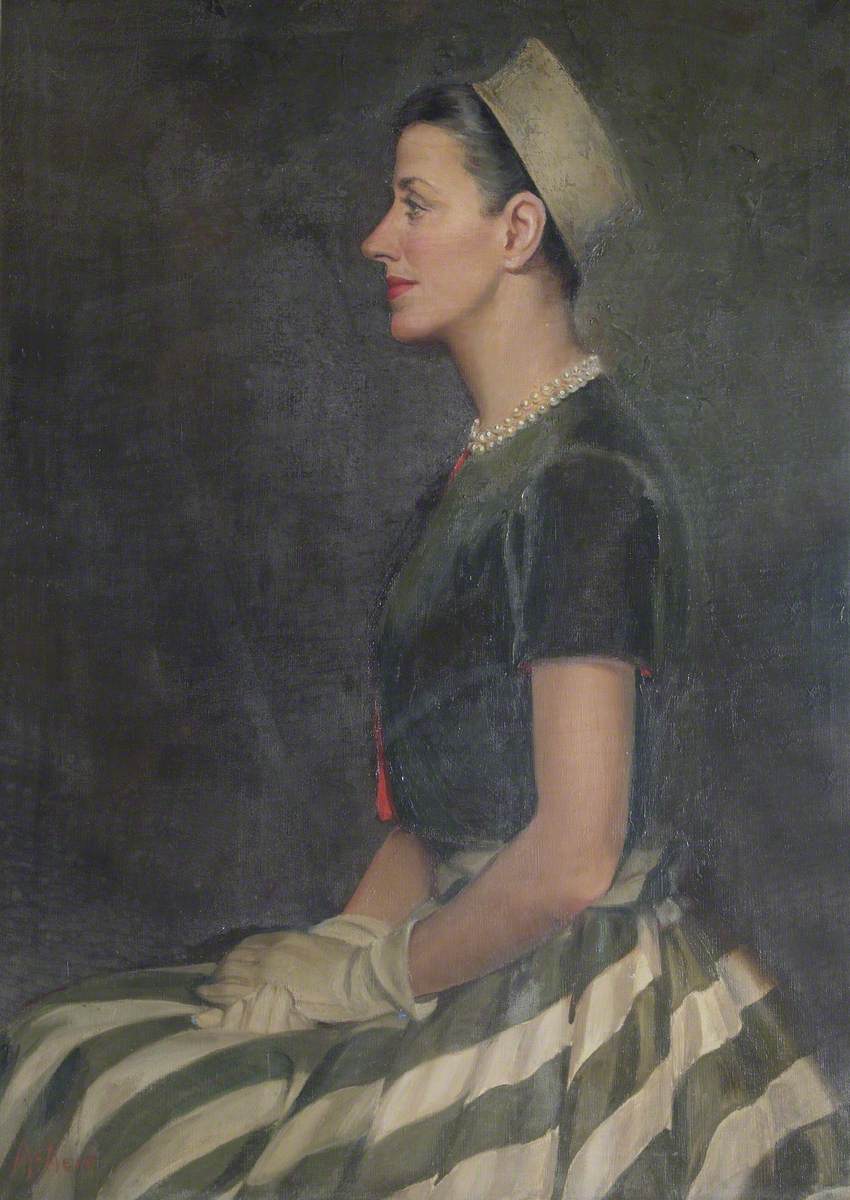Queer Places:
The Art Students League of New York, 215 W 57th St, 10019
Algonquin Hotel, 59 W 44th St, 10036
57 W 57th St, New York, NY 10019
Rhinebeck Cemetery
Rhinebeck, Dutchess County, New York, USA
 Neysa Moran McMein (January 24, 1888 – May 12, 1949) was an American
illustrator and portrait painter who studied at
The School of The Art Institute of Chicago and
Art Students League of New York.
Alexander Woollcott never
married or had children, although he had some notable female friends,
including
Dorothy Parker and
Neysa McMein, to whom he reportedly proposed the day after she had just
wed her new husband, Jack Baragwanath. Woollcott once told McMein that “I’m
thinking of writing the story of our life together. The title is already
settled.” McMein: “What is it?” Woollcott: “Under Separate Cover.”[4]
Neysa Moran McMein (January 24, 1888 – May 12, 1949) was an American
illustrator and portrait painter who studied at
The School of The Art Institute of Chicago and
Art Students League of New York.
Alexander Woollcott never
married or had children, although he had some notable female friends,
including
Dorothy Parker and
Neysa McMein, to whom he reportedly proposed the day after she had just
wed her new husband, Jack Baragwanath. Woollcott once told McMein that “I’m
thinking of writing the story of our life together. The title is already
settled.” McMein: “What is it?” Woollcott: “Under Separate Cover.”[4]
McMein began her career as an illustrator
and during World War I, she traveled across France entertaining military
troops with
Dorothy Parker and made posters to support the war effort. She was made an
honorary
non-commissioned officer in the
United States Marine Corps for her contributions to the war effort.
McMein was a successful illustrator of magazine covers, advertisements, and
magazine articles for national publications, like
McClure's,
McCall's,
The Saturday Evening Post, and
Collier's.
McMein created the portrait of a fictional housewife "Betty
Crocker" for
General Mills. She was also a successful portrait painter who painted the
portraits of presidents, actors, and writers.
Algonquin Round Table members were entertained at her West 57th Street
studio, where she was known for her active parties.
Life magazine wrote an article about adult party games, which featured
stories about McMein's parties. She had an open marriage to John G.
Baragwanath, during which she had affairs with
Charlie Chaplin and
George Abbott. Baragwanath described their marriage as a successful one
based upon a deep friendship.

Sally James Farnham, Neysa Moran McMein, 1920, sculpture.
McMein and Farnham worked in neighboring studios at 57 West 57th Street. The
bust is dated 1920 and signed Sally James, a shortening of her full
signature, which she used randomly between 1917-1920. The bust is in a private
collection today.

Edna St Vincent Millay by Neysa McMein
 Helen
Hayes by Neysa McMein
Helen
Hayes by Neysa McMein

Dorothy Thompson by Neysa McMein

Amelia Earhart by Neysa McMein

Beatrice Lillie by Neysa McMein

Billie Burke by Neysa McMein

Janet Flanner by Neysa McMein
While in New York, Janet Flanner
moved in the circle of the Algonquin Round Table, but was not a member. She
also met the couple, Jane Grant and Harold Ross, through Neysa McMein. It was based on this connection that Harold Ross offered
Flanner the position of French Correspondent to the New Yorker.[1]
She was inducted into the
Society of Illustrators' Hall of Fame in 1984, 35 years after her death.
McMein was one of 20 Society of Illustrators' artists to have their work
published on a United States Postal Service Collectible Stamp sheet in 2001.
Marjorie Frances McMein[a]
was born in
Quincy, Illinois[2]
on January 24, 1888.[3]
She was the daughter of Harry Moran and Isabelle Parker McMein.[4]
Harry McMein was a reporter before he worked for the McMein Publishing
Company, a family business. Due to his alcoholism, his relationship with his
wife was strained.[5]
McMein had musical, acting, and artistic talent. After graduating with
honors in 1907 from the Quincy High School,[4]
she attended
The School of the Art Institute of Chicago. McMein worked at a large
millinery firm, where she became lead designer.[4]
In 1911[4]
or 1913, she went to New York City[1][5]
and after a brief stint as an actress
[2] in several of
Paul Armstrong's plays,[6]
she turned to commercial art. On the advice of a
numerologist, she adopted the name Neysa.[2]
John Baragwanath, her husband, stated that she chose the name Neysa after
meeting one of
Homer Davenport's fillies at his stables. Whatever the original impetus
for the change, McMein thought that the name Neysa "had a commercial value"
above that of her birth name.[4]
McMein studied at the
Art Students League of New York[7][1]
in 1914.[5]
McMein sold her first drawing to the
Boston Star in 1914.[5]
She created
Harry Horowitz's portrait in 1915 before he was executed for
Herman Rosenthal's murder.[5]
That year, she sold an illustration for the cover of
The Saturday Evening Post[5]
and her Misinformation illustration appeared on the May 8, 1915, cover
of
Puck magazine.[8]
She became known for her portrayal of "All American Girls."[4]
McMein made posters for French and United States governments during World
War I, as did Thelma Cudlipp, Helen Hyde[7]
and
Mary Brewster Hazelton.[9]
Posters that she made also were used by the
American Red Cross in its fund-raising campaigns.[4]
She traveled across France to entertain the troops in 1918.[4]
Of her time at the
Western Front, McMein said, "Since I have lived through air bombing I
never will be frightened by anything on earth. The terror of air raids cannot
be imagined. They are heralded by the blowing of sirens and the ringing of
church bells, and amid this din the lights are extinguished and then suddenly
come the bombs, falling no one knows where. The noise they made is worse than
that of the battles."[5]
McMein made portraits of some of the soldiers, drew cartoons, and colored
the design of the Indian head insignia that was then used by the
93rd Bomb Squadron to denote the number of German planes that a given
plane shot down by drawing a German black cross over one of the bear teeth in
a necklace worn around the Indian head.[10][b]
She returned to the United States to care for her mother after her father
died.[4]
While in Quincy, she spoke at two fund-raising drives. "[McMein] was the main
attraction. The theater was filled. She was an excellent speaker; very witty
and clever," according to Sarah Carney.[4]
For her efforts supporting the U.S. war effort, McMein was appointed an
honorary
non-commissioned officer in the
United States Marine Corps, one of only three women to be so honored.[11]
Her illustrations appeared on the covers and within articles for
McClure's
magazine by 1919.[13][c]
By the 1920s, McMein and
Jessie Willcox Smith were two of the major women magazine illustrators of
their time. Together, they created hundreds of covers for
McCall's
and
Good Housekeeping magazines.[14]
Joseph Bernt, author of the article "The Girl on the Magazine Cover: The
Origins of Visual Stereotypes in American Mass Media" found that both women
and
Norman Rockwell generally portrayed women in covers and illustrations as
mothers, with scenes centered around children, during the 1920s and 1930s.
Within the covers of the magazine were illustrations made by the three artists
to sell consumer products, like Orange Crush, Ivory soap, Chesterfield
cigarettes, and Holeproof Hosiery.[15]
Following World War I, increased emphasis of family life was presented in mass
media following a period when
woman's suffrage and the
New Woman
were depicted in publications from the late 1800s according to Bernt.[15]
Carolyn Kitch, author of the book The Girl on the Magazine Cover,
finds, however, that McMein created illustrations of confident, modern
New Women
for her magazine covers,[16]
while Jessie Wilcox Smith concentrated more steadily on children.[16]
From 1923 through 1937, McMein created all of McCall's covers.[16]
She also supplied work to
National Geographic,
Woman's Home Companion,[4]
Collier's, and
Photoplay.[3]
McMein earned up to $2,500 (estimated equivalent to $32,777 in 2019)[d]
per cover illustration.[2]
She created advertising graphics for
Cadillac,
Lucky Strike cigarettes and
Palmolive soap.[3][4]
Together with artists
Howard Chandler Christy and
Harrison Fisher, McMein constituted the jury for Motion Picture Classic
magazine's "Fame and Fortune" contest of 1921/1922, which discovered the
It girl Clara Bow.[17]
Other promotional activities including judging Coney Island beauty contests or
opening movie houses.[18]
McMein designed silk textiles in the mid-1920s, three examples of which are in
the collection of the
Metropolitan Museum of Art.[19]
In December 1929, she consulted with
Studebaker's design department, with five other women artists and
decorators.[20]
General Mills commissioned her to create the image of
Betty Crocker, a fictional housewife in 1936. She created an official
portrait of Betty Crocker by combining features of the home economists
employed by the company, which helped reinforce that Crocker was a real
person.[21]
The image of the "ageless" 32-year-old was used in advertising and on
packaging until 1955 when Hilda Taylor painted an updated Betty, who also wore
bright red and white clothing.[22]
Like the Betty Crocker image, "Miss McMein was herself a kind of American
demigoddess: the most courted of commercial artists, hostess in her New York
studio to all of the 'Algonquin
wits'—Benchley,
Parker,
Franklin P. Adams—a wit herself. Sophistication lay rouge-deep upon the
personalities of her cover girls; beneath lay reassuring testimonials to
health and wholesomeness," wrote James Gray, author of Business Without
Boundary: The Story of General Mills.[23]
In April 1938, McCall's Magazine did not renew McMein's contract to
produce illustrations for the magazine. By then, magazines could
cost-effectively publish color photographs using four-color machines.[5]
McMein entered the field of portraiture, at first using pastels to depict
Dorothy Parker,
Edna St. Vincent Millay, and
Helen Hayes.[18]
She painted portraits of presidents
Herbert Hoover and
Warren G. Harding, author
Anne Morrow Lindbergh, and actors
Charlie Chaplin and
Beatrice Lillie.[3]
McMein also painted
Katharine Cornell,[24]
Kay Francis,[25]
Janet Flanner,
Dorothy Thompson,
Anatole France,
Charles Evans Hughes and Count
Ferdinand von Zeppelin.[5]
She mentored photographer
Lee Miller.[18]
Her father died in 1918 while McMein was overseas entertaining the troops.
She moved her mother Belle from Quincy, Illinois to live with her in New York.[4]
She was an "ardent supporter" of women's political, sexual, and economic
rights.[5]
By 1920, McMein had walked in suffrage parades, traveled overseas extensively,
and had ridden in Count Zeppelin's dirigible.[6]
She rode across an Arab desert with a woman journalist and friend and was
proposed to by an Arab sheik in Algiers. McMein, who was a talented musician,
had written an opera by that time, too.[6]
In 1921, McMein was among the first to join the
Lucy Stone League, an organization that fought for women to preserve their
birth names after marriage in the manner of
Lucy
Stone.[1][26]
McMein—described as a tall, athletic, grave, and beautiful red-head[e]—became
a regular member of the
Algonquin Round Table set,[28][4]
formed after the end of the war.[5]
Her West 57th Street studio in New York City became an "outpost" to the
Algonquin Hotel,[28][4]
which appealed to the "Bohemian" nature of its members,[2]
which included
Dorothy Parker,
Alexander Woollcott,
Edna
Ferber,
Irving Berlin,
Robert Sherwood,
Franklin Pierce Adams,
Robert Benchley,
Alice Duer Miller,
Harpo
Marx, and
Jascha Heifetz.[28]
She was prone to working in her smock at an easel as her guests enjoyed lively
discussions and piano playing.[5]
Berlin finished composing
What'll I Do at McMein's piano during one of her Round Table parties.[29]
McMein provided the cover illustration of Berlin's biography by Alexander
Woollcott.[29]
Walt
Disney,
Ethel Barrymore,
Cole
Porter,[4]
George Gershwin,
H.G. Wells, and
George Bernard Shaw were friends.[5]
Dorothy Parker moved in with McMein in 1920 before renting an apartment in the
same building.[5]
McMein's mother died in 1923.[4]
The same year, McMein married John G. Baragwanath, a mining engineer and
author,[4]
whom she met at a party given by
Irene Castle. Baragwanth was interested in the striking, fine-featured
woman playing the piano while others danced and sang around her.[5]
McMein and Baragwanath had a daughter Joan[4]
in 1924.[5]
Theirs was an
open marriage, and though the proprieties generally were observed, there
were exceptions. In his memoirs, the lyricist and publicist
Howard Dietz recalled hearing that on one occasion, when Neysa noticed
that her model for the day was impatient to leave, she asked: "Have you got a
heavy date?" Model: "Yes, with a great guy, Jack Baragwanath."[30]
Meanwhile, Neysa was involved for several years with the Broadway director
George Abbott, leading
Alexander Woollcott to say that "we now call Neysa’s place in
Port Washington the 'Abbottoir.'"[31]
She also had affairs with
Robert Benchley,[5]
Charlie Chaplin,[2]
who had a house near her cottage in Port Washington,[18]
and a platonic relationship with
Irving Berlin.[2]
This occurred during a period when "[w]omen are for the first time demanding
to live the forbidden experience directly and draw conclusions on this basis,"
according to
Beatrice Hinkle in an article for The Nation.[5]
McMein lived a varied life in search of fun. She interspersed her life as
an artist with riding on the back of an elephant in a parade, taking a swim on
a whim, and enjoying parties.[18]
She hosted parties with games for adults to entertain artists, writers, actors
and other celebrities. Her guests—like
Bing
Crosby,
Anne
Shirley,
Robert Young, and
Bennett Cerf—engaged in games like a quickfire, multiple team version of
charades called "The Game", that is sometimes attributed to McMein.[32]
The spelling game, where each person on a team wore a sign with one letter and
played against another team so see who could arrange themselves the fastest in
the proper order to spell a word, was played at her parties. McMein and the
games that she employed at her parties were featured in a
Life magazine article in 1946.[32]
McMein also entertained at the house she bought with Baragwanath on the
North Shore of
Long
Island in
Sands Point.[5]
In 1942, she broke her back by falling downstairs during a sleepwalking
episode. McMein was then required to have surgery to graft part of her hip to
her spine.[5]
McMein died of cancer on May 12, 1949,[3][5]
in New York City[1]
and was survived by daughter Joan and her husband John Baragwanath.
In her will, McMein bequeathed monies to purchase works of arts annually by
the
Whitney Museum of American Art. The museum bought 72 purchases from 1956,
none of which were McMein's works. Like other illustrators' works, her
illustrations were not considered fine art.[33]
In 1984, McMein was inducted into the
Society of Illustrators' Hall of Fame.[34]
The United States Post Office released a 20-stamp collection in February
2001 that are based upon works created by 20 Society of Illustrators' artists,
including McMein,
Rockwell Kent,
Al Parker,
Howard
Pyle,
Jessie Smith, and
Joseph Leyendecker.[35][36]
My published books:


BACK TO HOME PAGE

- https://en.wikipedia.org/wiki/Neysa_McMein
 Neysa Moran McMein (January 24, 1888 – May 12, 1949) was an American
illustrator and portrait painter who studied at
The School of The Art Institute of Chicago and
Art Students League of New York.
Alexander Woollcott never
married or had children, although he had some notable female friends,
including
Dorothy Parker and
Neysa McMein, to whom he reportedly proposed the day after she had just
wed her new husband, Jack Baragwanath. Woollcott once told McMein that “I’m
thinking of writing the story of our life together. The title is already
settled.” McMein: “What is it?” Woollcott: “Under Separate Cover.”[4]
Neysa Moran McMein (January 24, 1888 – May 12, 1949) was an American
illustrator and portrait painter who studied at
The School of The Art Institute of Chicago and
Art Students League of New York.
Alexander Woollcott never
married or had children, although he had some notable female friends,
including
Dorothy Parker and
Neysa McMein, to whom he reportedly proposed the day after she had just
wed her new husband, Jack Baragwanath. Woollcott once told McMein that “I’m
thinking of writing the story of our life together. The title is already
settled.” McMein: “What is it?” Woollcott: “Under Separate Cover.”[4]

 Helen
Hayes by Neysa McMein
Helen
Hayes by Neysa McMein





